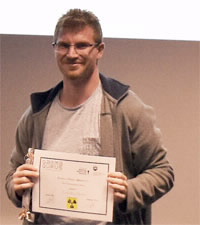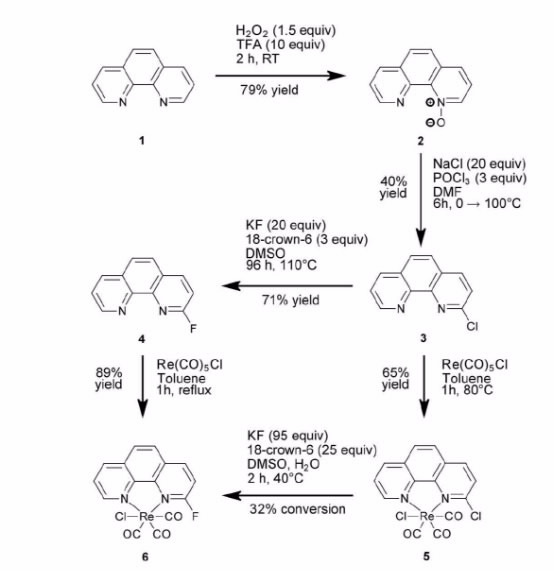ANSTO researchers have led the development of a new method for producing PET radiotracers. The discovery utilises the transition metal rhenium to promote fluorine-18 radiolabelling under aqueous, low temperature conditions.
The method circumvents the need for dry conditions, and purification steps, which saves time and gives PET radiotracers in very high yields.
 |
| Mitchell Klenner receiving the industry sponsored award at Innovations and Radiation Applications 2017 for his work on a new method of producing PET radiotracers; one of two awards for the investigation. |
Fluorine-18, the most commonly used radioisotope in PET imaging, must be attached to vectors in order to diagnose disease. The best example is where fluorine-18 is attached to glucose in order to make [18F]FDG for cancer imaging.
This new method has the potential to improve production of PET radiotracers like FDG, but also facilitate development of new radiotracers by allowing previously challenging vectors to be radiolabelled in high yields under mild conditions.
Because a radiotracer decays, radio-synthesis needs to be performed quickly, efficiently and in high yield, so there is enough radiotracer to scan all patients at a PET medical centre.
“Improving methods for incorporation of fluorine-18 has been a longstanding challenge for the radiotracer community. This research is the first example of a rhenium promoted radio-fluorination, an unprecedented, exciting discovery in the radiochemistry field,” said senior author Dr Benjamin Fraser, Radiotracer Method and Organic Chemistry Task leader at ANSTO.
 |
| Synthesis of radiolabelling precursors and non-radioactive standards |
Fraser explained that a rhenium complex was selected because of its potential for development as a dual modality PET/optical imaging agent. PET allows diagnosis of tumour location and then optical luminescence guides surgical removal of the tumour.
“The choice of rhenium proved fortuitous for the incorporation of F-18 and was good example of ‘chance favouring the prepared mind’ as the result was not predicted but very significant.
It’s also important that the reaction can be done in water, as this simplifies subsequent formulation of the radiotracer in saline for injection into a patient in a clinical setting,” said Fraser.
The study involved the use of microfluidic technologies that had several advantages for the investigation. Dr Giancarlo Pascali, co-senior investigator on the project who is based at the Camperdown cyclotron facility, supervised the radiochemistry work under microfluidic radiolabelling conditions.
“Microfluidic technologies allowed us to optimise all the reaction parameters very quickly, such as temperature, time, solvent and additives. We can optimise a given radiolabelling reaction in only three days, which under normal conditions would take one month to complete.
Another benefit of microfluidics is that we work with only very small amounts of radioactivity,” said Fraser.
Fraser points out that at this stage the radiotracer has not been tested for use with PET.
“The next step is working on conjugating the tracer to new biological vectors, but also applying the new rhenium method to established radiotracers. We can then also investigate its potential use as a dual modality probe.”
A large team of researchers from the Human Health and the Radioisotopes and Radiotracers platform at ANSTO, Curtin University, The University of Sydney, Monash University and Western Sydney University contributed to the study, which has just been published in Chemistry – A European Journal.
PhD student Mitchell Klenner, who received an Australian Institute of Nuclear Science and Engineering (AINSE) post graduate scholarship, has been invited to present the work at The International Symposium on Radiopharmaceutical Sciences in May 2017.
Klenner will receive the prestigious Wiley Award at the conference in recognition of the impact of the work. Recently he also presented the work at Innovations and Radiation Applications 2017 in Wollongong and received the industry sponsored award for best student presentation.
Fraser said, “It is fantastic to see Mitchell get due recognition for his diligent, hard work. His passion and enthusiasm for research at ANSTO is inspiring.”
http://onlinelibrary.wiley.com/doi/10.1002/chem.201700440/epdf
Published: 26/04/2017


